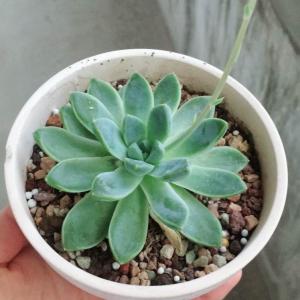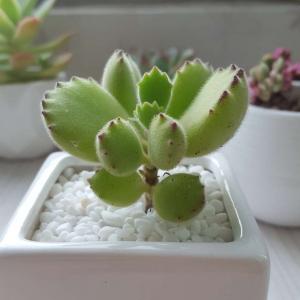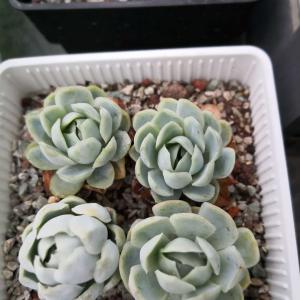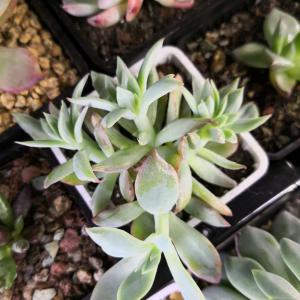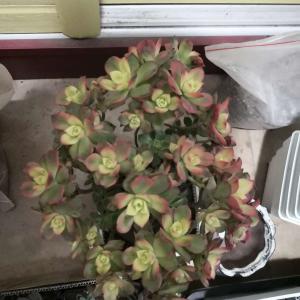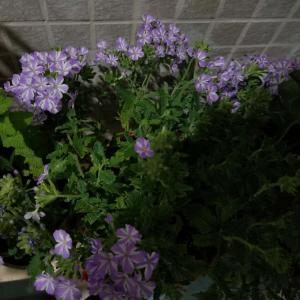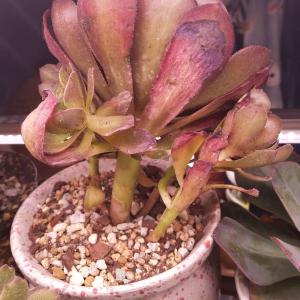文章
权问薇
2018年05月23日

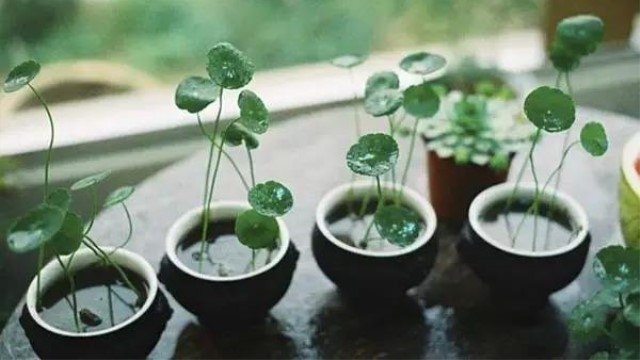
一、养殖环境
1、土壤:它对土壤并没有太高的要求,即使在贫瘠的土壤也能生长,不过它最喜欢疏松、保水性好的土壤。
2、施肥:在它生长旺期间隔15-20天追肥一次,如果是盆栽或者容器养殖,那就要适量减少施肥。
3、浇水:它喜欢在湿润的环境中生长,夏季要及时浇水,提高空气中的湿度,冬季盆土要保持微微干燥,不要有积水以免导致烂根。
4、温度:铜钱草在10-25℃的温度中会更好的生长,它喜欢温暖且潮湿的生长环境,但是不耐寒,冬季最低温度不能低于5℃,夏季最高温度不能高于32℃,若温度较高它就会进入到休眠状态,停止生长。

二、繁殖方法
分株繁殖:将带有2个节的根放在清水浸泡2天,有节的地方就会长出根须,将根放到培养土上,盖上一层土再放些碎石子,浇水要没过碎石子,大概4-5天就会长出小株。要经常给它补水,一般以水能浸湿碎石子最佳。
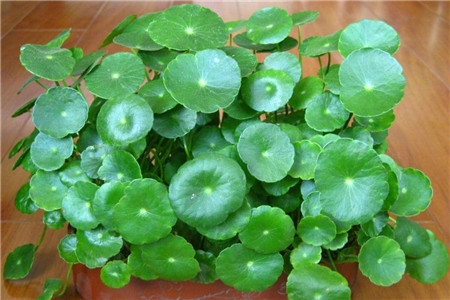
三、常见病虫害
铜钱草病虫害一般发生较少,它生长及适应能力很强,不用做特别护理,若是生长密集就要修剪并加强通风透气,以免植株黄化。
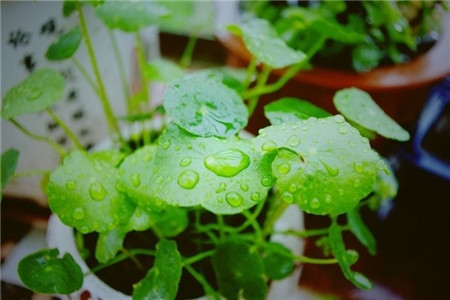
1
4
文章
Miss Chen
2018年05月22日

Description: This perennial plant is ¾–2½' tall and unbranched, except toward the apex where the flowers occur. The central stem is green to purple, 4-angled, and hairy to glandular-hairy. Often, the margins of the stem along its angles are shaded purple. The hairs of the stem are widely spreading. Pairs of opposite leaves occur along the entire length of the stem. These leaves are 1½–3" long and ¾–1¾" across; they are lanceolate-oblong to oval-ovate in shape, while their margins are crenate to crenate-serrate and ciliate. Generally, upper leaves are more narrow in shape than the leaves below. Leaf bases are truncate, rounded, or broadly wedge-shaped, while leaf tips are blunt. The upper leaf surface is medium to dark green and mostly glabrous, while the lower leaf surface is pale green and pubescent or hairy (especially along the major veins). The petioles are up to ¾" long with grooved upper surfaces; they are more or less hairy.
The central stem terminates in a spike-like raceme of flowers up to 4" long. In addition to this raceme, secondary racemes are sometimes produced from the axils of the upper leaves. The central stalk of each raceme is 4-angled, green to purplish green, and glandular-hairy; the hairs are widely spreading. Individual flowers along the raceme are ½-¾" long; their 2-lipped corollas are strongly ascending, but their mouths open laterally. Each flower consists of a pale to dark blue-violet corolla, a short green calyx, 4 inserted stamens, and a 4-lobed ovary with a single style. The corolla has a hood-like upper lip and a descending lower lip; the back and apex of the hood are more or less finely pubescent. The lower lip has irregular blotches of white (usually in pairs along the sides of a central blue-violet vein). In addition to these lips, there are also a pair of small lateral lobes. The lateral lobes are attached to the upper lip; they are often whitish and recurved. The calyx is glandular-hairy and shallowly divided into two lobes; there is a conspicuous protuberance on the back of the calyx.

The pedicels of the flowers are short (about 4 mm. in length), relatively stout, and pubescent. At the pedicel bases, there are pubescent leafy bracts up to 1¼" long and ½" across; they are lanceolate-oblong or elliptic-oblong in shape. The margins of these leafy bracts are ciliate and either toothless (entire) or sparingly crenate-serrate. The blooming period occurs from late spring to mid-summer, lasting about 3-4 weeks. Afterwards, the corollas become detached and wither away, while the persistent calyces become swollen and enclose the developing nutlets. There are 1-4 nutlets per calyx (often only 1 or 2). The small nutlets are minutely tuberculate. The calyces eventually split open to eject the nutlets; this may be caused in part by raindrop logistics. The root system is fibrous and short-rhizomatous.
Cultivation: The preference is light shade to partial sun, mesic to dry-mesic conditions, and an acidic soil containing some organic material.

Range & Habitat: The native Hairy Skullcap is occasional in southern Illinois, while in the rest of the state it is largely absent (see Distribution Map). Illinois lies along the northern range-limit of this species. However, a northern outlier population occurs in SE Michigan and NW Indiana. Habitats include rocky woodlands, bluffs, wooded slopes, rocky areas along streams, and well-drained bottoms of sandstone canyons. Hairy Skullcap is found in higher quality natural areas. In some areas of southern Illinois, it is currently threatened by the spread of an invasive species, Japanese Stilt Grass (Microstegium vimineum).
Faunal Associations: The nectar and pollen of the flowers attract various bees. Butterflies and skippers may also visit the flowers, but they are less effective at cross-pollination. The leaves of Hairy Skullcap and other Scutellaria spp. (Skullcaps) are attacked by several skeletonizing leaf beetles (Phyllobrotica spp.) and the Shining Flea Beetle (Asphaera lustrans). In particular, Phyllobrotica circumdata has been observed on Hairy Skullcap. The larvae of two micro-moths also feed on the foliage of Scutellaria spp. (Skullcaps): Caloptilia scutellariella and Prochoreutis inflatella. Larvae of the former moth are blotch leaf-miners, while larvae of the latter moth skeletonize the leaves. The bitter foliage is not eaten by mammalian herbivores.

Photographic Location: A wooded sandstone canyon in southern Illinois.
Comments: This is another native species of Scutellaria (Skullcap) that could be cultivated in shaded gardens. Both the foliage and flowers are reasonably attractive. The bitter foliage does not have a mint fragrance. It is possible to confuse Hairy Skullcap (Scutellaria elliptica) with some of the other woodland Scutellaria spp. in Illinois. It differs from Heart-Leaved Skullcap (Scutellaria ovata) by having less wide leaves that lack cordate bases (with the possible exception of the lowermost leaves). It also differs from Downy Skullcap (Scutellaria incana) by having spreading glandular hairs on its stems, flowering stalks, and calyces. The foliage and calyces of Downy Skullcap are more short-pubescent or canescent and they lack glandular hairs. Another woodland species, Showy Skullcap (Scutellaria serrata), has glabrous foliage and larger flowers (1" in length or more). Across its range, Hairy Skullcap varies somewhat in the extent of its hairiness: the typical variety is less hairy than var. hirsuta.
The central stem terminates in a spike-like raceme of flowers up to 4" long. In addition to this raceme, secondary racemes are sometimes produced from the axils of the upper leaves. The central stalk of each raceme is 4-angled, green to purplish green, and glandular-hairy; the hairs are widely spreading. Individual flowers along the raceme are ½-¾" long; their 2-lipped corollas are strongly ascending, but their mouths open laterally. Each flower consists of a pale to dark blue-violet corolla, a short green calyx, 4 inserted stamens, and a 4-lobed ovary with a single style. The corolla has a hood-like upper lip and a descending lower lip; the back and apex of the hood are more or less finely pubescent. The lower lip has irregular blotches of white (usually in pairs along the sides of a central blue-violet vein). In addition to these lips, there are also a pair of small lateral lobes. The lateral lobes are attached to the upper lip; they are often whitish and recurved. The calyx is glandular-hairy and shallowly divided into two lobes; there is a conspicuous protuberance on the back of the calyx.

The pedicels of the flowers are short (about 4 mm. in length), relatively stout, and pubescent. At the pedicel bases, there are pubescent leafy bracts up to 1¼" long and ½" across; they are lanceolate-oblong or elliptic-oblong in shape. The margins of these leafy bracts are ciliate and either toothless (entire) or sparingly crenate-serrate. The blooming period occurs from late spring to mid-summer, lasting about 3-4 weeks. Afterwards, the corollas become detached and wither away, while the persistent calyces become swollen and enclose the developing nutlets. There are 1-4 nutlets per calyx (often only 1 or 2). The small nutlets are minutely tuberculate. The calyces eventually split open to eject the nutlets; this may be caused in part by raindrop logistics. The root system is fibrous and short-rhizomatous.
Cultivation: The preference is light shade to partial sun, mesic to dry-mesic conditions, and an acidic soil containing some organic material.

Range & Habitat: The native Hairy Skullcap is occasional in southern Illinois, while in the rest of the state it is largely absent (see Distribution Map). Illinois lies along the northern range-limit of this species. However, a northern outlier population occurs in SE Michigan and NW Indiana. Habitats include rocky woodlands, bluffs, wooded slopes, rocky areas along streams, and well-drained bottoms of sandstone canyons. Hairy Skullcap is found in higher quality natural areas. In some areas of southern Illinois, it is currently threatened by the spread of an invasive species, Japanese Stilt Grass (Microstegium vimineum).
Faunal Associations: The nectar and pollen of the flowers attract various bees. Butterflies and skippers may also visit the flowers, but they are less effective at cross-pollination. The leaves of Hairy Skullcap and other Scutellaria spp. (Skullcaps) are attacked by several skeletonizing leaf beetles (Phyllobrotica spp.) and the Shining Flea Beetle (Asphaera lustrans). In particular, Phyllobrotica circumdata has been observed on Hairy Skullcap. The larvae of two micro-moths also feed on the foliage of Scutellaria spp. (Skullcaps): Caloptilia scutellariella and Prochoreutis inflatella. Larvae of the former moth are blotch leaf-miners, while larvae of the latter moth skeletonize the leaves. The bitter foliage is not eaten by mammalian herbivores.

Photographic Location: A wooded sandstone canyon in southern Illinois.
Comments: This is another native species of Scutellaria (Skullcap) that could be cultivated in shaded gardens. Both the foliage and flowers are reasonably attractive. The bitter foliage does not have a mint fragrance. It is possible to confuse Hairy Skullcap (Scutellaria elliptica) with some of the other woodland Scutellaria spp. in Illinois. It differs from Heart-Leaved Skullcap (Scutellaria ovata) by having less wide leaves that lack cordate bases (with the possible exception of the lowermost leaves). It also differs from Downy Skullcap (Scutellaria incana) by having spreading glandular hairs on its stems, flowering stalks, and calyces. The foliage and calyces of Downy Skullcap are more short-pubescent or canescent and they lack glandular hairs. Another woodland species, Showy Skullcap (Scutellaria serrata), has glabrous foliage and larger flowers (1" in length or more). Across its range, Hairy Skullcap varies somewhat in the extent of its hairiness: the typical variety is less hairy than var. hirsuta.
0
0
文章
Miss Chen
2018年05月22日

Description: This herbaceous perennial plant is 1–2½' tall, branching occasionally. The stems are light green to pale red or purple, glabrous, and veined. The leaves are alternate, opposite, or basal. The basal and lower leaves are palmately divided into 5 leaflets; these compound leaves span up to 5" long and across, and their petioles are up to 6" long. The middle to upper leaves are trifoliate with 3 leaflets; they are smaller in size and usually sessile. The leaflets are up to 2½" long and 1" across; they are oblanceolate, elliptic, obovate, or ovate in shape. Each leaflet is shallowly cleft and coarsely serrated along the margins; the bottom of each leaflet is wedge-shaped and sessile. Both the leaves and their petioles (if any) are glabrous.
Each upper stem terminates in 1-5 umbels of flowers. Each umbel is globoid or semi-globoid and spans up to ½" across; it consists of 20-60 tiny flowers and their pedicels. The stalk (or ray) of each umbel is up to 1" long. Each umbel has 1-3 perfect flowers (male & female reproductive organs), while the remaining flowers are staminate (male only). Whether perfect or staminate, each flower has a short green calyx with 5 ovate teeth, 5 greenish yellow petals that are obcordate in shape, and 5 exerted stamens with conspicuous anthers. The anthers are initially yellow, but they later become brown. In addition, each perfect flower has a bristly globoid ovary and a pair of long recurved styles. These styles are longer than the bristles of the ovary. The blooming period occurs from late spring to mid-summer and lasts about 2-3 weeks. Each bur-like fruit contains a pair of seeds. The root system is fibrous. Colonies often develop in favorable habitats.
Cultivation: This plant is typically found in partial sun to medium shade, moist to slightly dry conditions, and fertile loamy soil. While the flowers are not very showy, it can be used as a ground cover in shaded areas.
Range & Habitat: Common Black Snakeroot is occasional to common in most areas of Illinois (see Distribution Map), where it is native. Habitats include deciduous woodlands, areas along woodland paths, thickets, shaded seeps, and fence rows that are overgrown with woody vegetation. Sometimes this species invades shaded areas of gardens. Tolerance to degradation of woodland habitat is above average.

Faunal Associations: The nectar and pollen of the flowers attract small bees (Halictid & Andrenid) and various flies. White-Tailed Deer and other mammalian herbivores avoid consumption of the foliage because of its bitter taste. The small prickly fruits can cling to the fur of mammals, feathers of birds, and clothing of humans; this helps to distribute the seeds to new locations.
Photographic Location: A mesic area of Busey Woods in Urbana, Illinois.
Comments: Common Black Snakeroot can be distinguished from other Sanicula spp. (Black Snakeroots) by its greenish yellow flowers. Other Black Snakeroots have greenish white flowers. The recurved styles of Common Black Snakeroot are longer than the prickles of the ovary, while other Black Snakeroots have more erect styles that are shorter or the same length as the prickles of their ovaries. The common name (Black Snakeroot) probably refers to the pioneer belief that the bitter roots were useful in treating snake bites, although this is highly doubtful. Another scientific name of Common Black Snakeroot is Sanicula gregaria, which resulted in the common name, 'Clustered Black Snakeroot.'
Each upper stem terminates in 1-5 umbels of flowers. Each umbel is globoid or semi-globoid and spans up to ½" across; it consists of 20-60 tiny flowers and their pedicels. The stalk (or ray) of each umbel is up to 1" long. Each umbel has 1-3 perfect flowers (male & female reproductive organs), while the remaining flowers are staminate (male only). Whether perfect or staminate, each flower has a short green calyx with 5 ovate teeth, 5 greenish yellow petals that are obcordate in shape, and 5 exerted stamens with conspicuous anthers. The anthers are initially yellow, but they later become brown. In addition, each perfect flower has a bristly globoid ovary and a pair of long recurved styles. These styles are longer than the bristles of the ovary. The blooming period occurs from late spring to mid-summer and lasts about 2-3 weeks. Each bur-like fruit contains a pair of seeds. The root system is fibrous. Colonies often develop in favorable habitats.
Cultivation: This plant is typically found in partial sun to medium shade, moist to slightly dry conditions, and fertile loamy soil. While the flowers are not very showy, it can be used as a ground cover in shaded areas.
Range & Habitat: Common Black Snakeroot is occasional to common in most areas of Illinois (see Distribution Map), where it is native. Habitats include deciduous woodlands, areas along woodland paths, thickets, shaded seeps, and fence rows that are overgrown with woody vegetation. Sometimes this species invades shaded areas of gardens. Tolerance to degradation of woodland habitat is above average.

Faunal Associations: The nectar and pollen of the flowers attract small bees (Halictid & Andrenid) and various flies. White-Tailed Deer and other mammalian herbivores avoid consumption of the foliage because of its bitter taste. The small prickly fruits can cling to the fur of mammals, feathers of birds, and clothing of humans; this helps to distribute the seeds to new locations.
Photographic Location: A mesic area of Busey Woods in Urbana, Illinois.
Comments: Common Black Snakeroot can be distinguished from other Sanicula spp. (Black Snakeroots) by its greenish yellow flowers. Other Black Snakeroots have greenish white flowers. The recurved styles of Common Black Snakeroot are longer than the prickles of the ovary, while other Black Snakeroots have more erect styles that are shorter or the same length as the prickles of their ovaries. The common name (Black Snakeroot) probably refers to the pioneer belief that the bitter roots were useful in treating snake bites, although this is highly doubtful. Another scientific name of Common Black Snakeroot is Sanicula gregaria, which resulted in the common name, 'Clustered Black Snakeroot.'
0
0
文章
Miss Chen
2018年05月22日

Description: This herbaceous plant is a biennial or short-lived perennial; it is about 1-2' tall, branching occasionally. The stems are glabrous and light green; they are terete or somewhat angular. The alternate leaves are usually trifoliate, although some of the smaller upper leaves are simple. The lower leaves often appear to be palmate with 5 leaflets, but this is because each lateral leaflet has been deeply divided into 2 large lobes. In outline, the lower compound leaves are nearly orbicular in outline (up to 5" wide and 5" across, excluding the petioles) while the upper compound leaves are more narrow. The leaflets and large lobes are obovate, ovate, or broadly elliptic in shape, while their margins are coarsely double-serrated and sometimes cleft along their margins. Leaf venation within each leaflet and lobe is pinnate. The upper leaf surface is yellowish green (in bright sunlight) to dark green (in shade) and glabrous. The lower leaves have long petioles, while those of the upper leaves are much shorter. These petioles are light green, glabrous, and slightly sheathed at their bases; they are grooved above and convex below.
The upper stems terminate in small umbels or compound umbels of greenish white flowers. Each umbel consists of 1-4 umbellets and spans up to 2½" across. Each umbellet has 2-3 pistillate or perfect flowers and about 2-6 staminate flowers (less often, there will be 7-15 staminate flowers); these flowers form a tight cluster that is irregularly globular in shape. The perfect and pistillate flowers are more conspicous because of their bur-like ovaries. These ovaries are about 3-5 mm. in length, globoid-ovoid in shape, and green; their outer surfaces are covered with hooked prickles (about 1 mm. in length). Each flower has 5 greenish white petals and a green calyx with 5 linear-lanceolate lobes; these lobes are shorter than the prickles of the ovaries. The styles of perfect and pistillate flowers (less than 1 mm. in length) are also shorter than the prickles of the ovaries. Each staminate or perfect flower has 5 short stamens.

The blooming period occurs from late spring to mid-summer and lasts about 3 weeks for a colony of plants. There is no noticeable floral scent. Each bur-like fruit contains 2 seeds. The root system is fibrous. This plant spreads by reseeding itself and it occasionally forms colonies.
Cultivation: The preference is light to medium shade, moist to slightly dry conditions, and a loamy soil with an abundance of organic matter.
Range & Habitat: Canadian Black Snakeroot is a common plant that occurs in nearly all counties of Illinois (see Distribution Map), where it is native. Habitats include mesic deciduous woodlands, north-facing bluffs, areas along woodland paths, edges of shaded seeps, fence rows with woody vegetation, edges of yards underneath trees, and flower gardens in shady areas. This plant occurs in both natural habitats of varying quality and disturbed areas.

Faunal Associations: The flowers attract few insect pollinators, although occasionally they are visited by Halictid bees (Lasioglossum spp.), masked bees (Hylaeus spp.), and Syrphid flies, which suck nectar. An aphid, Aphis clydesmithi, sucks plant juices at the stem base and root collar, while another aphid, Aphis saniculae, sucks plant juices from the undersides of the leaves. Canadian Black Snakeroot is the preferred host plant of the latter aphid. The bitter foliage is avoided by grazing livestock and probably other mammalian herbivores as well. The small burry fruits cling readily to the feathers of birds, fur of mammals, and clothing of humans; this helps to distribute the seeds far and wide.
Photographic Location: Underneath a lawn tree in Urbana, Illinois.

Comments: Canadian Black Snakeroot is not very showy, in part because it does not bloom until after the deciduous trees in woodlands have developed their leaves. Except for the bur-like ovaries, the flowers are inconspicuous. This species is well-adapted to the shady conditions that exist underneath trees during the summer, and it can become a minor weed along the edges of yards and in flower gardens. Except for Sanicula gregaria (Clustered Black Snakeroot), which has greenish yellow flowers, the various Sanicula spp. in Illinois have small greenish white flowers. The species of this latter group are rather difficult to distinguish. Canadian Black Snakeroot differs from Sanicula marilandica (Maryland Black Snakeroot) by its short styles, which are no longer than the prickles of its ovaries; the latter species has pairs of curved styles that are much longer than the prickles of its ovaries. Canadian Black Snakeroot differs from Sanicula trifoliata (Large-Fruited Black Snakeroot) by the size and shape of its burry fruits: The fruits of the former species are 3-5 mm. long and ovoid-globoid in shape, while the fruits of the latter species are at least 5.5 mm. in length and ovoid in shape. Furthermore, the calyx lobes of the latter species are as long or longer than the surrounding prickles, and its stamens are longer and more conspicuous than those Canadian Black Snakeroot.
The upper stems terminate in small umbels or compound umbels of greenish white flowers. Each umbel consists of 1-4 umbellets and spans up to 2½" across. Each umbellet has 2-3 pistillate or perfect flowers and about 2-6 staminate flowers (less often, there will be 7-15 staminate flowers); these flowers form a tight cluster that is irregularly globular in shape. The perfect and pistillate flowers are more conspicous because of their bur-like ovaries. These ovaries are about 3-5 mm. in length, globoid-ovoid in shape, and green; their outer surfaces are covered with hooked prickles (about 1 mm. in length). Each flower has 5 greenish white petals and a green calyx with 5 linear-lanceolate lobes; these lobes are shorter than the prickles of the ovaries. The styles of perfect and pistillate flowers (less than 1 mm. in length) are also shorter than the prickles of the ovaries. Each staminate or perfect flower has 5 short stamens.

The blooming period occurs from late spring to mid-summer and lasts about 3 weeks for a colony of plants. There is no noticeable floral scent. Each bur-like fruit contains 2 seeds. The root system is fibrous. This plant spreads by reseeding itself and it occasionally forms colonies.
Cultivation: The preference is light to medium shade, moist to slightly dry conditions, and a loamy soil with an abundance of organic matter.
Range & Habitat: Canadian Black Snakeroot is a common plant that occurs in nearly all counties of Illinois (see Distribution Map), where it is native. Habitats include mesic deciduous woodlands, north-facing bluffs, areas along woodland paths, edges of shaded seeps, fence rows with woody vegetation, edges of yards underneath trees, and flower gardens in shady areas. This plant occurs in both natural habitats of varying quality and disturbed areas.

Faunal Associations: The flowers attract few insect pollinators, although occasionally they are visited by Halictid bees (Lasioglossum spp.), masked bees (Hylaeus spp.), and Syrphid flies, which suck nectar. An aphid, Aphis clydesmithi, sucks plant juices at the stem base and root collar, while another aphid, Aphis saniculae, sucks plant juices from the undersides of the leaves. Canadian Black Snakeroot is the preferred host plant of the latter aphid. The bitter foliage is avoided by grazing livestock and probably other mammalian herbivores as well. The small burry fruits cling readily to the feathers of birds, fur of mammals, and clothing of humans; this helps to distribute the seeds far and wide.
Photographic Location: Underneath a lawn tree in Urbana, Illinois.

Comments: Canadian Black Snakeroot is not very showy, in part because it does not bloom until after the deciduous trees in woodlands have developed their leaves. Except for the bur-like ovaries, the flowers are inconspicuous. This species is well-adapted to the shady conditions that exist underneath trees during the summer, and it can become a minor weed along the edges of yards and in flower gardens. Except for Sanicula gregaria (Clustered Black Snakeroot), which has greenish yellow flowers, the various Sanicula spp. in Illinois have small greenish white flowers. The species of this latter group are rather difficult to distinguish. Canadian Black Snakeroot differs from Sanicula marilandica (Maryland Black Snakeroot) by its short styles, which are no longer than the prickles of its ovaries; the latter species has pairs of curved styles that are much longer than the prickles of its ovaries. Canadian Black Snakeroot differs from Sanicula trifoliata (Large-Fruited Black Snakeroot) by the size and shape of its burry fruits: The fruits of the former species are 3-5 mm. long and ovoid-globoid in shape, while the fruits of the latter species are at least 5.5 mm. in length and ovoid in shape. Furthermore, the calyx lobes of the latter species are as long or longer than the surrounding prickles, and its stamens are longer and more conspicuous than those Canadian Black Snakeroot.
0
0
文章
权问薇
2018年05月22日

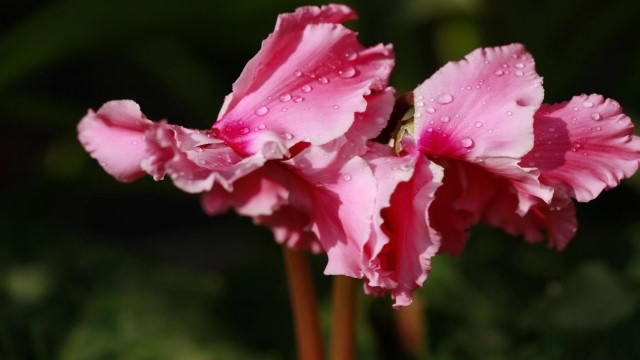
一、养殖环境
1、土壤:疏松、肥沃的土壤适合仙客来生长,在栽植的时候要将培养土进行消毒。
2、施肥:一般10-15天施一次即可,在翻盆和换土时可以适量施点基肥,施肥一定要薄肥勤施,在夏季温度较高时要停止施肥。
3、浇水:生长期间要保持土壤微微湿润,盆内不能有积水。夏季若是没有继续生长,可以正常浇水。
4、温度:仙客来在冬季适宜温度为10-22℃,昼夜温差不能超过10℃。夜间温度为8℃时可以正常开花,不过花期会减短,若低于6℃它就没有办法正常开花。
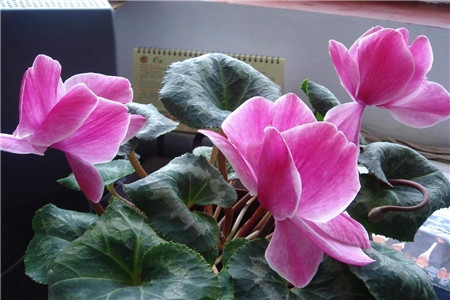
二、繁殖方法
1、播种繁殖:要先将种子消毒,再将它泡在温水中24小时,播种时种子间距为1-2厘米,浇水后将它放在阴暗的环境,温度最好控制在18℃,用薄膜将其包住,20天左右就会发芽。
2、切茎繁殖:球茎的直接要3厘米以上并有两处以上芽眼,才可以分割,分割刀具要进行消毒,直切到根部,切口处涂上草木灰,晾干之后就可以进行栽植了。
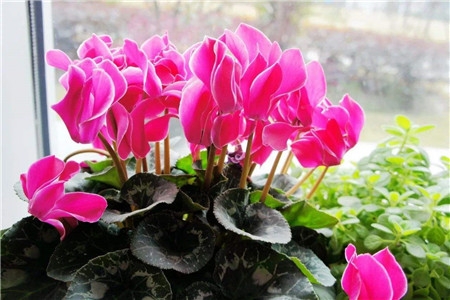
三、常见病虫害
1、常见的虫害:蚜虫、红蜘蛛及卷叶虫等,可以用呋喃丹进行防治。
2、常见的病害:叶斑病、软腐病等,发病的时候可以用托布津水溶液进行喷洒治疗。

1
1
文章
Miss Chen
2018年05月21日

Description: This annual plant is ½–2' tall, branching occasionally in the upper half. The stems are smooth, terete, glabrous, and translucent. They are light green, greyish green, or reddish green in appearance; some of the larger stems may be slightly ribbed. The opposite leaves are ¾–4" long and about one-half as much across. They are ovate, hairless, and coarsely serrated. Each leaf has a thin membranous texture with a prominent central vein and two conspicuous side veins. The upper surface is green or dark green, while the lower surface is light green or nearly white. The petioles of the leaves are quite long, frequently 1" in length or more.
From the axil of each upper leaf, there develops a narrow raceme of flowers up to 1" long. This raceme is usually shorter than the petiole, slightly curved, and more or less horizontal. Each plant has separate male and/or female flowers that are less than 1/8" (3 mm.) long, and they are either greenish white or greenish yellow. The male flowers have no petals, 4 sepals, and 4 stamens, while the female flowers have no petals, 3 sepals, and 1 pistil. Toward the inner surface of the sepals are small scales. The blooming period occurs from mid-summer to early fall, lasting about 1 month. There is no floral scent. Cross-pollination of the flowers is by wind. The tiny achenes are green, sometimes with black stripes. They can be blown about by the wind, and in this manner spread to new areas.

Cultivation: The preference is light shade, moist to wet conditions, and rich loamy soil. The foliage is little bothered by disease and is it is usually quite attractive. Standing water is tolerated if it is temporary.
Range & Habitat: The native Clearweed is a common woodland plant that occurs in almost all counties of Illinois (see Distribution Map). Habitats include poorly drained areas of upland forests, floodplain forests, crevices in rocky canyons, and shady or partially shaded wetland areas, including seeps, borders of small streams, and low areas along vernal pools. The moist wooded areas where this plant occurs are typically dominated by such deciduous trees as Silver Maple, Sugar Maple, American Sycamore, River Birch, Green Ash, etc. Clearweed often forms large colonies by reseeding itself.

Faunal Associations: The flowers are wind-pollinated, therefore they don't attract many insects. The caterpillars of the following butterflies feed on the foliage of Clearweed: Nymphalis milberti (Milbert's Tortoiseshell), Polygonia comma (Comma), Polygonia interrogationis (Question Mark), and Vanessa atalanta (Red Admiral). These caterpillars feed on other members of the Nettle family as well. The larvae of a moth, Cosmopterix pulcherimella (Beautiful Cosmopterix Moth), mine the leaves. An aphid, Pseudasiphonaphis corni, uses Clearweed as a summer host, where they suck juices from the stems and flowering stalks. This species is also one of the host plants of a polyphagous leafhopper, Empoasca recurvata.

Photographic Location: The plants were growing in a shady area along a small stream at Meadowbrook Park in Urbana, Illinois.
Comments: The most unusual characteristic of this plant is the translucency of the foliage – this has been useful in biology classes to show the uptake of liquids from the roots into the stems and leaves. A less common species of Clearweed, Pilea fontana, has stems that are less translucent and its achenes are black, rather than green. Clearweed resembles other members of the Nettle family as well, but it lacks the stinging hairs that can be found on Urtica dioica (Stinging Nettle) and Laportea canadensis (Wood Nettle). While Boehmeria cylindrica (False Nettle) lacks stinging hairs, its stems aren't translucent and its racemes of flowers are more erect and longer than Clearweed's racemes.
From the axil of each upper leaf, there develops a narrow raceme of flowers up to 1" long. This raceme is usually shorter than the petiole, slightly curved, and more or less horizontal. Each plant has separate male and/or female flowers that are less than 1/8" (3 mm.) long, and they are either greenish white or greenish yellow. The male flowers have no petals, 4 sepals, and 4 stamens, while the female flowers have no petals, 3 sepals, and 1 pistil. Toward the inner surface of the sepals are small scales. The blooming period occurs from mid-summer to early fall, lasting about 1 month. There is no floral scent. Cross-pollination of the flowers is by wind. The tiny achenes are green, sometimes with black stripes. They can be blown about by the wind, and in this manner spread to new areas.

Cultivation: The preference is light shade, moist to wet conditions, and rich loamy soil. The foliage is little bothered by disease and is it is usually quite attractive. Standing water is tolerated if it is temporary.
Range & Habitat: The native Clearweed is a common woodland plant that occurs in almost all counties of Illinois (see Distribution Map). Habitats include poorly drained areas of upland forests, floodplain forests, crevices in rocky canyons, and shady or partially shaded wetland areas, including seeps, borders of small streams, and low areas along vernal pools. The moist wooded areas where this plant occurs are typically dominated by such deciduous trees as Silver Maple, Sugar Maple, American Sycamore, River Birch, Green Ash, etc. Clearweed often forms large colonies by reseeding itself.

Faunal Associations: The flowers are wind-pollinated, therefore they don't attract many insects. The caterpillars of the following butterflies feed on the foliage of Clearweed: Nymphalis milberti (Milbert's Tortoiseshell), Polygonia comma (Comma), Polygonia interrogationis (Question Mark), and Vanessa atalanta (Red Admiral). These caterpillars feed on other members of the Nettle family as well. The larvae of a moth, Cosmopterix pulcherimella (Beautiful Cosmopterix Moth), mine the leaves. An aphid, Pseudasiphonaphis corni, uses Clearweed as a summer host, where they suck juices from the stems and flowering stalks. This species is also one of the host plants of a polyphagous leafhopper, Empoasca recurvata.

Photographic Location: The plants were growing in a shady area along a small stream at Meadowbrook Park in Urbana, Illinois.
Comments: The most unusual characteristic of this plant is the translucency of the foliage – this has been useful in biology classes to show the uptake of liquids from the roots into the stems and leaves. A less common species of Clearweed, Pilea fontana, has stems that are less translucent and its achenes are black, rather than green. Clearweed resembles other members of the Nettle family as well, but it lacks the stinging hairs that can be found on Urtica dioica (Stinging Nettle) and Laportea canadensis (Wood Nettle). While Boehmeria cylindrica (False Nettle) lacks stinging hairs, its stems aren't translucent and its racemes of flowers are more erect and longer than Clearweed's racemes.
0
0
文章
Miss Chen
2018年05月20日

Description: This biennial plant is 1-2' tall, branching occasionally. The stems are light green, terete, and covered with spreading hairs; these hairs are often glandular. The alternate leaves are simple-pinnate; they are usually divided into 3-5 leaflets (rarely 7). The leaf blades are up to 5" long and 3" across; the petioles of these leaves become shorter as they ascend the stems. The leaflets of each blade are ovate, broadly ovate, oblong, or oblanceolate in shape; they are shallowly to deeply cleft and bluntly dentate along their margins. Often, the terminal leaflets are more deeply cleft than the lateral leaflets. Both leaf blades and petioles are more or less hairy. The upper surfaces of mature blades are medium to dark green; however, theClose-up of Flower earliest leaf-blades of the year have upper surfaces with silver-grey blotches. The upper stems terminate in racemes of 4-12 flowers; often there are a few secondary racemes that develop from the axils of the upper leaves. Buds and flowers are typically concentrated toward the apex of each raceme, while the developing fruits are located below on spreading pedicels. These pedicels are glandular-hairy and about ½" long. Each flower is about ½" across when it is in bloom; it consists of a 5-lobed corolla, a calyx with 5 sepals, 5 stamens, a slender style, and an ovary. The corolla can vary in color from pale lavender to deep blue-violet. The green sepals are linear-lanceolate and hairy; they become recurved during and after the blooming period. The style of each flower divides into 2 parts toward the middle of its length, while the stamens have finely hairy filaments and brownish anthers. The blooming period occurs during the late spring and lasts about a month. Each flower is replaced by an ovoid seed capsule that divides into 2 parts to release its seeds. This plant reproduces by reseeding itself.
Cultivation: The preference is dappled sunlight to light shade, moist conditions, and a rather rich loam or silt-loam containing organic matter. After the flowering period, more shade from canopy trees is tolerated because this plant dies down. While this plant doesn't grow on rocks like some ferns, it tolerates soil that is somewhat thin and rocky from underlying bedrock if there is enough moisture.
Range & Habitat: The native Forest Phacelia occurs occasionally in the southern half of Illinois, while in the northern half of the state it is rare or absent (see Distribution Map). Habitats include moist areas of deciduous woodlands and rocky woodlands, rocky banks and low areas along woodland streams, moist depressions of bluffs, bottoms of sandstone canyons, and lower slopes of ravines. This wildflower is typically found in various moist areas of rocky woodlands.
Faunal Associations: The nectar and pollen of the flowers attract primarily bees (long-tongued & short-tongued); less common floral visitors include butterflies, skippers, and wasps. The foliage of Phacelia spp. (Phacelias) is eaten by the the oligophagous Scelolyperus wilcoxi (Skeletonizing Leaf Beetle sp.). Information about the edibility of the foliage to mammalian herbivores is unavailable.

Photographic Location: The bottom of a sandstone canyon along a woodland stream at the Portland Arch in west-central Indiana.
Comments: Forest Phacelia is another lovely woodland wildflower in the Waterleaf family. This species and other Phacelia spp. (Phacelias) are closely related to the Hydrophyllum spp. (Waterleaf species), which also occur in woodlands and bloom at about the same time. Among the species in Illinois, the style of a Phacelia is divided toward the middle of its length, while the style of a Waterleaf is divided toward its apex; this is the easiest way to distinguish these two groups of very similar wildflowers. Compared to other Phacelias in Illinois, Forest Phacelia usually has larger flowers (about ½" across, if not more) and the lobes of its corollas are smooth, rather than conspicuously fringed. Some species of Waterleaf are similar to it, but they lack tripartite leaves or the lobes of their corollas are less widely spreading when the flowers are blooming. If all else fails, they can be distinguished by their styles, as described above. Another common of Phacelia bipinnatifida is Loose-Flowered Phacelia.
Cultivation: The preference is dappled sunlight to light shade, moist conditions, and a rather rich loam or silt-loam containing organic matter. After the flowering period, more shade from canopy trees is tolerated because this plant dies down. While this plant doesn't grow on rocks like some ferns, it tolerates soil that is somewhat thin and rocky from underlying bedrock if there is enough moisture.
Range & Habitat: The native Forest Phacelia occurs occasionally in the southern half of Illinois, while in the northern half of the state it is rare or absent (see Distribution Map). Habitats include moist areas of deciduous woodlands and rocky woodlands, rocky banks and low areas along woodland streams, moist depressions of bluffs, bottoms of sandstone canyons, and lower slopes of ravines. This wildflower is typically found in various moist areas of rocky woodlands.
Faunal Associations: The nectar and pollen of the flowers attract primarily bees (long-tongued & short-tongued); less common floral visitors include butterflies, skippers, and wasps. The foliage of Phacelia spp. (Phacelias) is eaten by the the oligophagous Scelolyperus wilcoxi (Skeletonizing Leaf Beetle sp.). Information about the edibility of the foliage to mammalian herbivores is unavailable.

Photographic Location: The bottom of a sandstone canyon along a woodland stream at the Portland Arch in west-central Indiana.
Comments: Forest Phacelia is another lovely woodland wildflower in the Waterleaf family. This species and other Phacelia spp. (Phacelias) are closely related to the Hydrophyllum spp. (Waterleaf species), which also occur in woodlands and bloom at about the same time. Among the species in Illinois, the style of a Phacelia is divided toward the middle of its length, while the style of a Waterleaf is divided toward its apex; this is the easiest way to distinguish these two groups of very similar wildflowers. Compared to other Phacelias in Illinois, Forest Phacelia usually has larger flowers (about ½" across, if not more) and the lobes of its corollas are smooth, rather than conspicuously fringed. Some species of Waterleaf are similar to it, but they lack tripartite leaves or the lobes of their corollas are less widely spreading when the flowers are blooming. If all else fails, they can be distinguished by their styles, as described above. Another common of Phacelia bipinnatifida is Loose-Flowered Phacelia.
0
1
文章
Miss Chen
2018年05月20日

Description: This perennial wildflower is about 1-2' tall and similarly across. It has a single erect stem that is hairless and unbranched; the stem terminates in a whorl of about 3 compound leaves. Each compound leaf is palmate with 5 widely spreading leaflets; the petiole (basal stalk) of each compound leaf is 2-5" long. Individual leaflets are 2½–6" long and ¾–2½" across; they are ovate to obovate, medium green, hairless, and finely serrated along their margins. The lower pair of leaflets are smaller in size than the other leaflets. The larger leaflets have longer petiolules (basal stalklets) than the smaller leaflets, and they have short slender tips.
From the terminal point of the central stem, there develops a single umbel of greenish white flowers. There are about 10-20 flowers per umbel; each umbel is about ½–¾" across. Individual flowers are only 1/8" (3 mm.) across; each flower has 5 spreading petals, a short tubular calyx, 5 stamens, and a pistil. The calyx has 5 tiny teeth. The blooming period occurs from early to mid-summer and lasts about 2 weeks. During the fall, fertile flowers are replaced by a small cluster of bright red berries spanning about ¾" across. Each berry is globoid-ovoid in shape and contains about 2 seeds. The root system consists of a fleshy taproot that is fusiform in shape (widest in the middle and tapering at both ends); this taproot can be several inches long. American Ginseng reproduces by reseeding itself.
Cultivation: The preference is medium to light shade, a rich loamy soil with abundant organic material, and mesic conditions.
Range & Habitat: The native American Ginseng is distributed throughout Illinois, but it is relatively uncommon. Populations have declined because of habitat destruction and overcollection of the fleshy roots. This wildflower is found mesic deciduous woodlands. Usually, such woodlands are high quality and little-disturbed.
Faunal Associations: Very little is known about floral-faunal relationships for this species. Probably small bees and various flies visit the flowers for nectar or pollen. The red berries are probably eaten to a limited extent by woodland birds that either nest or search for food on the ground; small rodents may eat the berries as well.
Photographic Location: Spitzler Woods Nature Preserve in Macon County, Illinois. This preserve contains a high quality deciduous woodland. The photograph was taken during the autumn, when the berries become mature.
Comments: It is unfortunate that this classic woodland wildflower has become uncommon. American Ginseng is a member of a small group of plants in the Araliaceae; these consist primarily of woodland wildflowers in Illinois. Another woodland wildflower that does not occur within the state, Panax trifolius (Dwarf Ginseng), is found further to the east. Dwarf Ginseng is smaller in size (about 6" tall) than American Ginseng, and its compound leaves are trifoliate, rather than palmate with 5 leaflets. The flowers and berries of these two species are similar to each other.
From the terminal point of the central stem, there develops a single umbel of greenish white flowers. There are about 10-20 flowers per umbel; each umbel is about ½–¾" across. Individual flowers are only 1/8" (3 mm.) across; each flower has 5 spreading petals, a short tubular calyx, 5 stamens, and a pistil. The calyx has 5 tiny teeth. The blooming period occurs from early to mid-summer and lasts about 2 weeks. During the fall, fertile flowers are replaced by a small cluster of bright red berries spanning about ¾" across. Each berry is globoid-ovoid in shape and contains about 2 seeds. The root system consists of a fleshy taproot that is fusiform in shape (widest in the middle and tapering at both ends); this taproot can be several inches long. American Ginseng reproduces by reseeding itself.
Cultivation: The preference is medium to light shade, a rich loamy soil with abundant organic material, and mesic conditions.
Range & Habitat: The native American Ginseng is distributed throughout Illinois, but it is relatively uncommon. Populations have declined because of habitat destruction and overcollection of the fleshy roots. This wildflower is found mesic deciduous woodlands. Usually, such woodlands are high quality and little-disturbed.
Faunal Associations: Very little is known about floral-faunal relationships for this species. Probably small bees and various flies visit the flowers for nectar or pollen. The red berries are probably eaten to a limited extent by woodland birds that either nest or search for food on the ground; small rodents may eat the berries as well.
Photographic Location: Spitzler Woods Nature Preserve in Macon County, Illinois. This preserve contains a high quality deciduous woodland. The photograph was taken during the autumn, when the berries become mature.
Comments: It is unfortunate that this classic woodland wildflower has become uncommon. American Ginseng is a member of a small group of plants in the Araliaceae; these consist primarily of woodland wildflowers in Illinois. Another woodland wildflower that does not occur within the state, Panax trifolius (Dwarf Ginseng), is found further to the east. Dwarf Ginseng is smaller in size (about 6" tall) than American Ginseng, and its compound leaves are trifoliate, rather than palmate with 5 leaflets. The flowers and berries of these two species are similar to each other.
0
0



